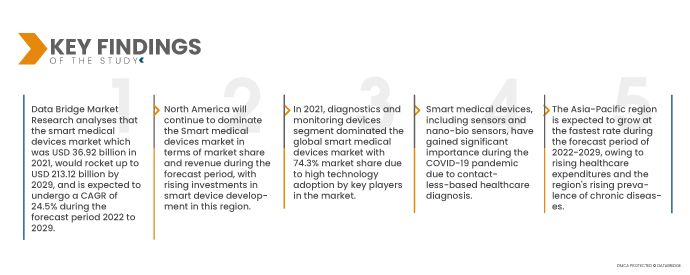Умные медицинские устройства являются важными медицинскими инструментами, которые врачи используют для мониторинга жизненно важных физиологических параметров различных заболеваний. Эти умные устройства предназначены для повышения качества ухода за пациентами путем мониторинга данных в реальном времени и передачи их врачам через подключенное устройство. Использование умных медицинских устройств имеет несколько преимуществ. Оно экономит время и расходы на посещение больницы, тем самым помогая людям быть более осведомленными о своем здоровье и физической форме.
Доступ к полному отчету по адресу https://www.databridgemarketresearch.com/reports/global-smart-medical-devices-market
Data Bridge Market Research анализирует, что рынок интеллектуальных медицинских устройств , который в 2021 году составил 36,92 млрд долларов США, к 2029 году вырастет до 213,12 млрд долларов США и, как ожидается, будет испытывать среднегодовой темп роста в 24,5% в течение прогнозируемого периода с 2022 по 2029 год. Растущий спрос на интеллектуальные устройства из-за простоты их использования, растущий технологический прогресс и растущая распространенность хронических заболеваний, требующих круглосуточного мониторинга, являются основными драйверами, стимулирующими спрос на рынок интеллектуальных медицинских устройств в прогнозируемый период. Однако ожидается, что расхождения в результатах будут препятствовать росту рынка интеллектуальных медицинских устройств в прогнозируемый период.

Рост популярности беспроводных устройств по всему миру будет способствовать росту рынка
Передовые технологии принесли революционную эпоху в здравоохранение, и люди ежедневно все больше узнают о своем здоровье и физической форме. Растущее использование смартфонов изменило образ жизни. Умные устройства связывают пациентов с врачом, передавая важные медицинские данные в режиме реального времени из больницы, дома и мобильного оборудования. С ростом внедрения беспроводных устройств и совместимых со смартфонами устройств производители также разрабатывают более инновационные и передовые медицинские устройства, которые, как ожидается, будут стимулировать рынок.
Область отчета и сегментация рынка
Отчет Метрика
|
Подробности
|
Прогнозируемый период
|
2022-2029
|
Базовый год
|
2021
|
Исторические годы
|
2020 (Можно настроить на 2014 - 2019)
|
Количественные единицы
|
Выручка в млрд долл. США, объемы в единицах, цены в долл. США
|
Охваченные сегменты
|
Материал (натриево-кальциевое стекло, свинцовое стекло, термостойкое и другие), Стиль (стекло без ножки, бокалы, повседневного использования и другие), Канал сбыта (B2B, специализированные магазины, супермаркеты/гипермаркеты, электронная коммерция и другие), Ценовой диапазон (средний, премиум и эконом), Конечное использование (отели и рестораны, бары и кафе, бытовые нужды, корпоративные столовые и другие)
|
Страны, охваченные
|
США, Канада и Мексика в Северной Америке, Германия, Франция, Великобритания, Нидерланды, Швейцария, Бельгия, Россия, Италия, Испания, Турция, Остальная Европа в Европе, Китай, Япония, Индия, Южная Корея, Сингапур, Малайзия, Австралия, Таиланд, Индонезия, Филиппины, Остальная часть Азиатско-Тихоокеанского региона (APAC) в Азиатско-Тихоокеанском регионе (APAC), Саудовская Аравия, ОАЭ, Южная Африка, Египет, Израиль, Остальной Ближний Восток и Африка (MEA) как часть Ближнего Востока и Африки (MEA), Бразилия, Аргентина и Остальная часть Южной Америки как часть Южной Америки
|
Охваченные участники рынка
|
Johnson & Johnson Private Limited (США), Abbott (США), Apple Inc. (США), Medtronic (Ирландия), F. Hoffman-La Roche Ltd. (США), Fitbit, Inc. (США), Dexcom Inc. (США), NeuroMetrix, Inc. (США), CeQur Simplicity (Швейцария), Huawei Devices Co., Ltd. (Китай), West Pharmaceutical Services, Inc. (США), Sonova (Швейцария), BAE Systems (Великобритания), Seiko Epson Corporation (Япония), Insulet Corporation (США), Garmin Ltd. (США), SAMSUNG (Южная Корея), LG Electronics (Южная Корея)
|
Данные, отраженные в отчете
|
Помимо информации о рыночных сценариях, таких как рыночная стоимость, темпы роста, сегментация, географический охват и основные игроки, рыночные отчеты, подготовленные Data Bridge Market Research, также включают в себя глубокий экспертный анализ, эпидемиологию пациентов, анализ воронки продаж, анализ ценообразования и нормативную базу.
|
Анализ сегмента:
Глобальный рынок интеллектуальных медицинских устройств подразделяется на семь основных сегментов, которые различаются по типу продукта, технологии, модальности, применению, конечному пользователю и каналу сбыта.
- На основе типа продукта глобальный рынок интеллектуальных медицинских устройств сегментируется на диагностические и мониторинговые устройства и терапевтические устройства. В 2021 году сегмент диагностических и мониторинговых устройств доминировал на мировом рынке интеллектуальных медицинских устройств с долей рынка 74,3% благодаря внедрению высоких технологий ключевыми игроками на рынке.
- По типу глобальный рынок интеллектуальных медицинских устройств сегментируется на нательные (клеящиеся пластыри), внетелесные (зажим для ремня) и ручные. В 2021 году сегмент внетелесных (зажим для ремня) доминировал на мировом рынке интеллектуальных медицинских устройств с долей рынка 51,7 % из-за роста расходов на здравоохранение.
- На основе технологий глобальный рынок интеллектуальных медицинских устройств сегментируется на пружинные, моторизованные, ротационные насосы, расширяющиеся батареи, сжатый газ и другие. В 2021 году сегмент пружинных устройств доминировал на мировом рынке интеллектуальных медицинских устройств с долей рынка 35,9% из-за растущего спроса на интеллектуальные устройства на рынке.
- На основе модальности глобальный рынок интеллектуальных медицинских устройств сегментируется на носимые и не носимые. В 2021 году носимые устройства доминировали на мировом рынке интеллектуальных медицинских устройств с долей рынка 71,9 % из-за растущего спроса на беспроводные устройства для мониторинга состояния здоровья.
- На основе конечного пользователя глобальный рынок интеллектуальных медицинских устройств сегментируется на больницы, клиники, уход на дому, спортивные клубы и т. д. В 2021 году сегмент ухода на дому доминировал на мировом рынке интеллектуальных медицинских устройств с долей рынка 49,5% из-за увеличения численности гериатрического населения и распространенности хронических заболеваний, требующих постоянного мониторинга.
Сегмент домашнего ухода будет доминировать в сегменте конечного пользователя на рынке интеллектуальных медицинских устройств.
Сегмент домашнего ухода станет доминирующим сегментом среди интеллектуальных медицинских устройств. Это связано с растущим числом мероприятий по развитию инфраструктуры на рынке, особенно в развивающихся экономиках. Кроме того, рост и расширение химической и материальной промышленности по всему миру еще больше поддержит рост этого сегмента.
- На основе канала сбыта глобальный рынок интеллектуальных медицинских устройств сегментируется на аптеки, онлайн-каналы и др. В 2021 году сегмент онлайн-каналов доминировал на мировом рынке интеллектуальных медицинских устройств с долей рынка 63,2 % из-за растущего спроса на беспроводные и интеллектуальные устройства.
Сегмент онлайн-каналов будет доминировать в сегменте каналов дистрибуции на рынке интеллектуальных медицинских устройств.
Сегмент онлайн-канала станет доминирующим сегментом сегмента канала дистрибуции. Это связано с растущей доступностью через онлайн-канал на рынке, особенно в развивающихся экономиках. Кроме того, рост и расширение услуг по научно-исследовательским разработкам в глобальном масштабе еще больше поддержит рост этого сегмента.
Основные игроки
Data Bridge Market Research признает следующие компании в качестве игроков на рынке: Johnson & Johnson Private Limited (США), Abbott (США), Apple Inc. (США), Medtronic (Ирландия), F. Hoffman-La Roche Ltd. (США), Fitbit, Inc. (США), Dexcom Inc. (США), NeuroMetrix, Inc. (США), CeQur Simplicity (Швейцария), Huawei Devices Co., Ltd. (Китай), West Pharmaceutical Services, Inc. (США), Sonova (Швейцария), BAE Systems (Великобритания), Seiko Epson Corporation (Япония), Insulet Corporation (США), Garmin Ltd. (США), SAMSUNG (Южная Корея), LG Electronics (Южная Корея).
Развитие рынка

- Fitbit, Inc. объявила о выпуске Fitbit Sense в августе 2020 года. Это самые передовые на рынке умные часы для здоровья, оснащенные первым в мире электротермическим датчиком активности на умных часах, помогающим справляться со стрессом, и передовой технологией отслеживания сердечного ритма. Пользователи могут обнаружить незначительные электрические изменения в уровне потоотделения своей кожи, приложив ладонь к поверхности устройства. Результаты отображаются в приложении EDA Scan.
- NeuroMetrix, Inc. объявила о выпуске приложения Quell для Apple Watch для облегчения боли в сентябре 2020 года. Quell — это безрецептурное устройство TENS для лечения боли в колене, стопе и ноге. Его можно носить как днем, так и ночью. Пользователи могут настраивать и управлять терапией с помощью мобильного программного обеспечения для iPhone и телефонов Android.
- Компания Facedrive Health объявила о выпуске носимого устройства TraceSCAN V2 в январе 2021 года. TraceSCAN V2 включает в себя ряд новых функций, направленных на повышение точности, управления данными, решения проблем конфиденциальности и возможностей мониторинга основных показателей жизнедеятельности традиционных устройств Bluetooth (не GPS).
Региональный анализ
Географически в отчете о рынке рассматриваются следующие страны: США, Канада и Мексика в Северной Америке, Германия, Франция, Великобритания, Нидерланды, Швейцария, Бельгия, Россия, Италия, Испания, Турция, остальные страны Европы в Европе, Китай, Япония, Индия, Южная Корея, Сингапур, Малайзия, Австралия, Таиланд, Индонезия, Филиппины, остальные страны Азиатско-Тихоокеанского региона (APAC) в Азиатско-Тихоокеанском регионе (APAC), Саудовская Аравия, ОАЭ, Южная Африка, Египет, Израиль, остальные страны Ближнего Востока и Африки (MEA) как часть Ближнего Востока и Африки (MEA), Бразилия, Аргентина и остальные страны Южной Америки как часть Южной Америки.
Согласно анализу Data Bridge Market Research:
Северная Америка будет доминирующим регионом на рынке интеллектуальных медицинских устройств в прогнозируемый период с 2022 по 2029 год.
Северная Америка продолжит доминировать на рынке смарт-медицинских устройств с точки зрения доли рынка и доходов в течение прогнозируемого периода, с ростом инвестиций в разработку смарт-устройств в этом регионе. Из-за возросшего использования смартфонов и повышения осведомленности о своем здоровье и фитнесе Соединенные Штаты доминируют в североамериканском регионе.
По оценкам, Азиатско-Тихоокеанский регион станет самым быстрорастущим регионом на рынке интеллектуальных медицинских устройств в прогнозируемый период с 2022 по 2029 год.
Ожидается, что Азиатско-Тихоокеанский регион будет расти самыми быстрыми темпами в прогнозируемый период 2022-2029 годов из-за роста расходов на здравоохранение и распространенности хронических заболеваний. Ожидается, что Китай будет доминировать в Азиатско-Тихоокеанском регионе из-за роста инвестиций и государственной поддержки.
Влияние COVID -19
Умные медицинские устройства, включая датчики и нано-биодатчики, приобрели значительную важность во время пандемии COVID-19 из-за бесконтактной диагностики в здравоохранении. Носимые датчики могут определять жизненно важные сигналы человеческого тела, такие как частота сердечных сокращений, артериальное давление, цвет кожи, температура тела, частота дыхания, продолжительность сна и движение тела. Исследователи из Имперского колледжа Лондона и Фрайбургского университета объявили в апреле 2021 года, что они разрабатывают носимые устройства, которые можно использовать для создания сети медицинских данных о пациенте, что позволит проводить раннюю диагностику COVID-19, даже если у пациента нет симптомов.
Для получения более подробной информации об отчете о рынке интеллектуальных медицинских устройств нажмите здесь – https://www.databridgemarketresearch.com/reports/global-smart-medical-devices-market










